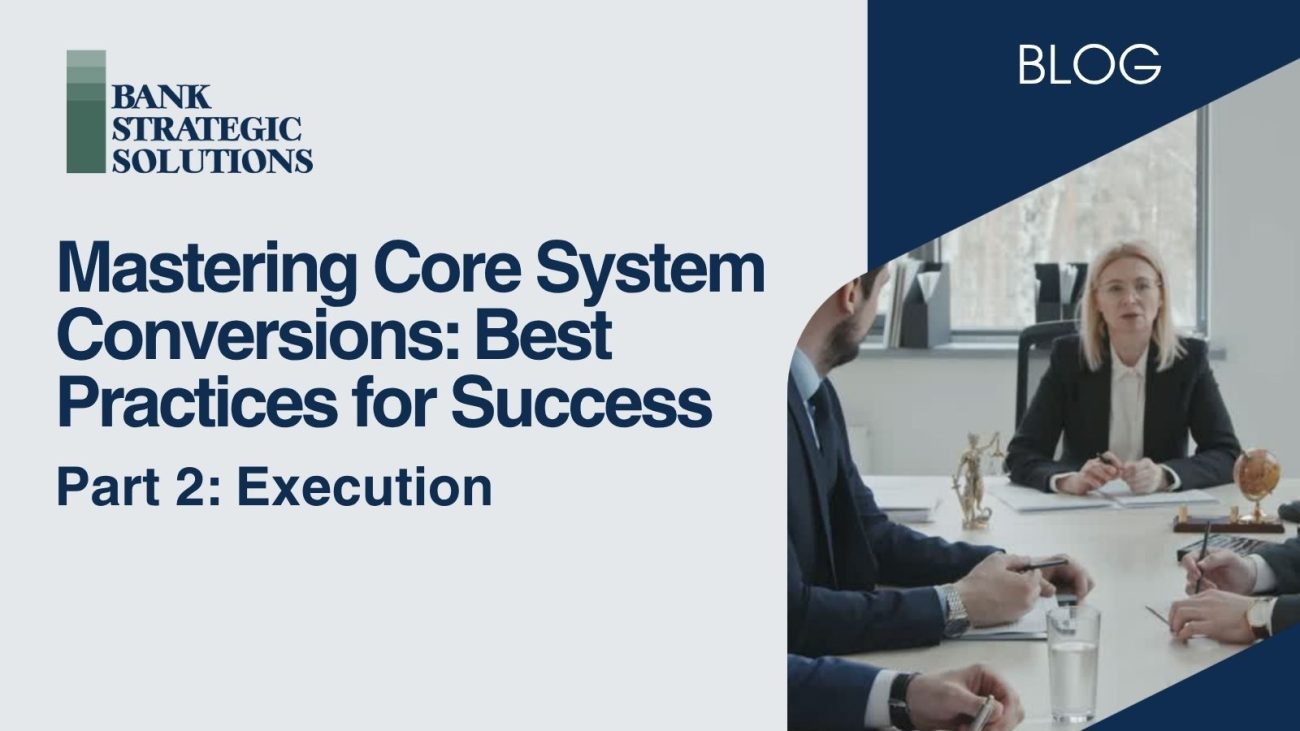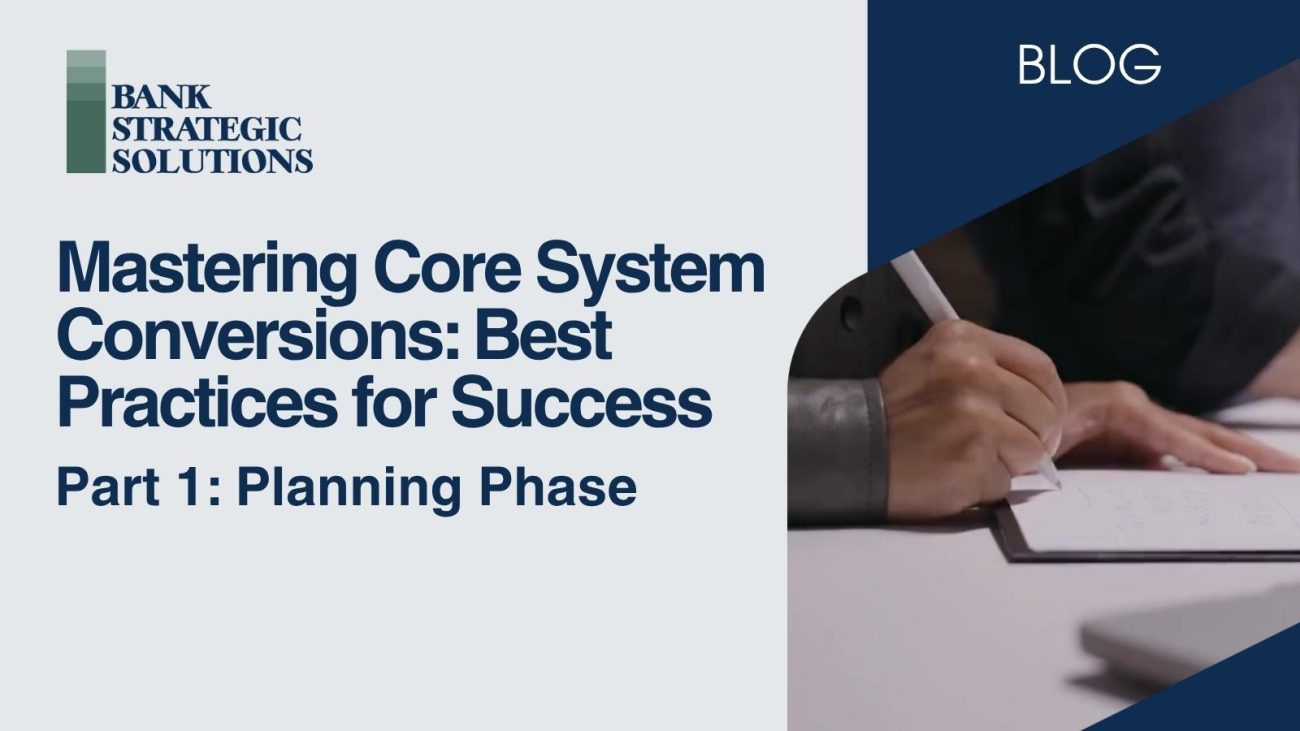Mastering Core System Conversions: Best Practices for Success
Part 2: Execution Core conversions are considered a necessary evil by many bankers. It’s a huge undertaking and impacts nearly everyone in the bank, not to mention customers.

We’ve seen them run well and we’ve seen customers negatively impacted when steps are missed. Planning is a key part as mentioned in Part 1. Now it’s time to focus on the Execution.
Consistent communication across all workstreams keeps the project on track.
1. Set the Table for Success
A successful communication plan is the baseline for setting realistic expectations of team members; internally, externally and cross-functionally. A cadence of regular meetings to monitor progress and identify delays or obstacles will lead to cross-team collaboration and eliminate significant roadblocks.
Best Practice: Consistent communication across all workstreams keeps the project on track. Facilitate the collaboration and coordination between business and technology teams to deliver on end-to-end objectives staying within the guidelines of the original scope.
2. Ensure Adequate Testing
Effective testing requires months of coordinated effort throughout implementation including data mapping, integration testing, contingency planning, and training. Execution of processing steps in a test scenario ensures the system will meet business needs. Testing should include any new processes and identify new procedures. This allows for full adoption of new methods and better utilization of the platform following conversion.
Key components of testing include data migration validation, end-user testing, and system integration testing with vendors. This comprehensive approach requires months of coordinated effort throughout the implementation to ensure all aspects function properly.
Best Practice: Treat testing as a dedicated work requirements for team members and manage distribution of their regular duties to provide capacity for the project. Defined milestones and committed resources are key. Also recognize that effective testing goes beyond technical validation—it’s about managing the human side of change. Staff must transition through the “Change Curve” as they move from familiar current processes to new procedures. This requires understanding that people naturally experience stages of resistance, exploration, and eventual acceptance when adopting new systems.
Design your testing phases to support this psychological transition. Allow adequate time for users to process new workflows, practice unfamiliar procedures, and build confidence with the new system. Rushing testing timelines often leads to poor user adoption and post-conversion struggles because staff haven’t had sufficient opportunity to internalize new processes.
Invest in pre-migration testing, data validation, and post-go-live monitoring will ensure that each testing phase helps moves users closer to full adoption and optimal utilization of the new platform’s capabilities.
3. Train and Empower Employees
Employees are the frontline during a conversion – and often the first to deal with glitches or broken workflows. Providing comprehensive, role-specific training can reduce errors and improve morale.
Best Practice: Build a training plan that includes sandbox environments, job aids, and Q&A forums. Designate internal “conversion champions” in each department.
4. Don’t Rush Post-Go-Live Optimization
The conversion doesn’t end at “Go-Live.” Continuous support, bug fixes, and feature enhancements are crucial to realizing the full value of the new core system.
Post-conversion success requires managing multiple moving timelines: your bank’s internal schedule, the de-converting core provider’s wind-down timeline, and the new core provider’s implementation expectations. Add third-party vendor connections to this mix, and the complexity becomes clear. This is why realistic expectation setting and cross-functional team collaboration are essential from day one.
Core conversions often feel like a failed project not because of software limitations, but because of flawed planning and rushed timelines that don’t account for these interdependencies. Success requires managing cross-functional teams and vendor deliverables while identifying risks and resource constraints early in the process.
Best Practice: Keep your implementation team engaged for at least 90 days post-launch to track metrics, capture user feedback, and plan for system tuning. Develop a comprehensive communication plan that sets realistic expectations across all stakeholders. Continue internal project team meetings and vendor coordination protocols to address unexpected breaks in data delivery for increased success. Remember that optimization is an ongoing process, not a post-launch afterthought.
Final Thought
Core system conversions are high-stakes, high-impact initiatives, but with proper planning, stakeholder alignment, and a relentless focus on customer and employee experience, they can also be transformative. The key is to treat the conversion not as a one-time event, but as a strategic evolution that sets the foundation for future success.
Recent Articles
- Mastering Core System Conversions: Best Practices for Success
 Part 2: Execution
Part 2: Execution
Core conversions are considered a necessary evil by many bankers. It’s a huge undertaking and impacts nearly everyone in the bank, not to mention customers. - Mastering Core System Conversions: Best Practices for Success
 Part 1: Planning Phase
Part 1: Planning Phase
A core system conversion is one of the most complex and consequential undertakings banks can face. It’s not just a technology switch; it’s a complete transformation that impacts operations, customer experience, compliance, and competitive positioning. - Mortgage Point: Credit Quality Concerns Ripple Through Banking Sector
 Credit quality became an increasing cause of concern among lenders and analysts after JPMorgan Chase CEO Jamie Dimon discussed his concern regarding recent bankruptcies… Read more: Mortgage Point: Credit Quality Concerns Ripple Through Banking Sector
Credit quality became an increasing cause of concern among lenders and analysts after JPMorgan Chase CEO Jamie Dimon discussed his concern regarding recent bankruptcies… Read more: Mortgage Point: Credit Quality Concerns Ripple Through Banking Sector